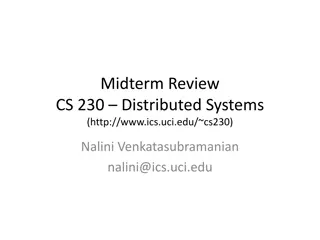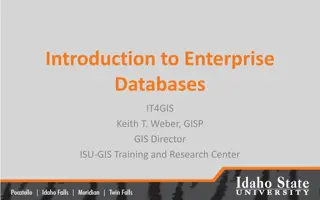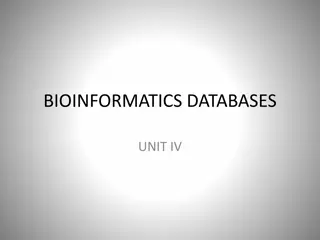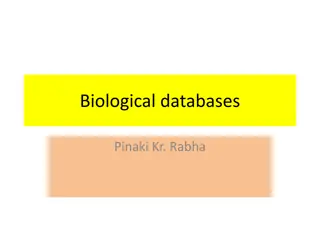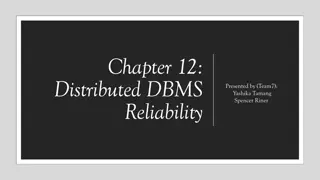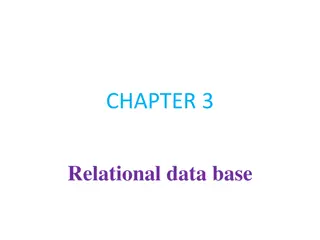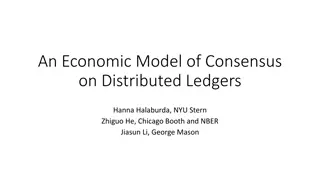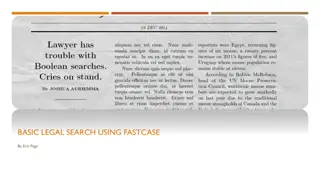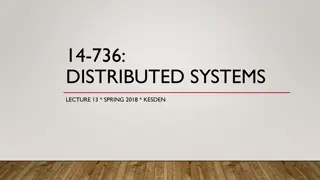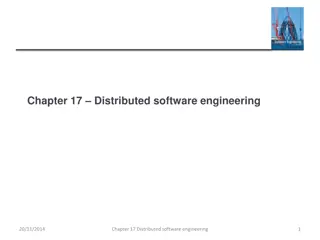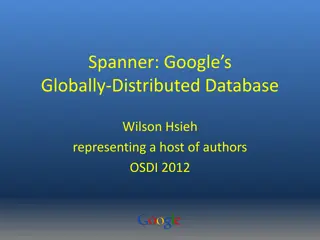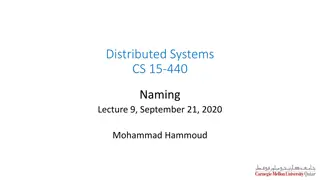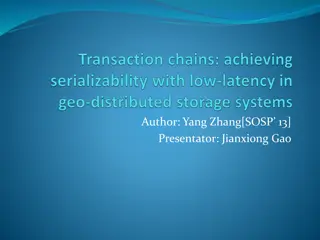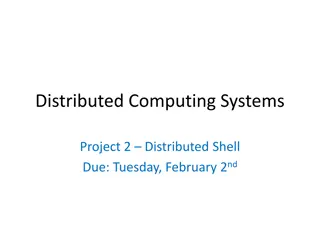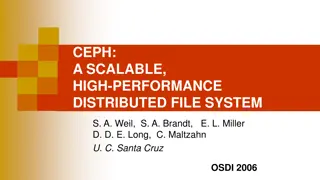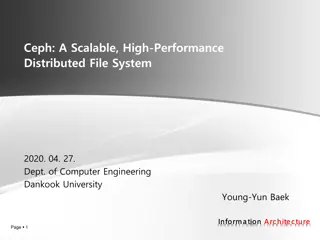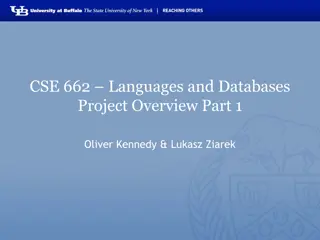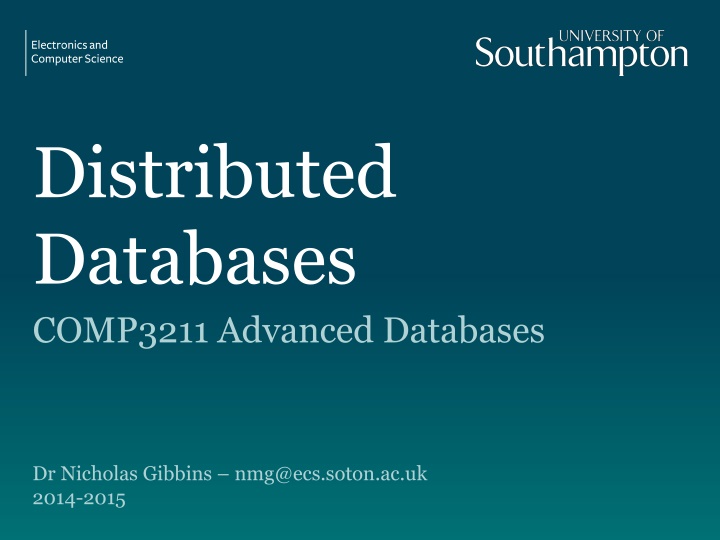
Advanced Principles of Distributed Databases and DDBMS
Explore key concepts like fragmentation, query processing, concurrency control, reliability, and more in the realm of distributed databases. Understand the principles of DDBMS including local autonomy, continuous operation, and location independence.
Download Presentation

Please find below an Image/Link to download the presentation.
The content on the website is provided AS IS for your information and personal use only. It may not be sold, licensed, or shared on other websites without obtaining consent from the author. If you encounter any issues during the download, it is possible that the publisher has removed the file from their server.
You are allowed to download the files provided on this website for personal or commercial use, subject to the condition that they are used lawfully. All files are the property of their respective owners.
The content on the website is provided AS IS for your information and personal use only. It may not be sold, licensed, or shared on other websites without obtaining consent from the author.
E N D
Presentation Transcript
Distributed Databases COMP3211 Advanced Databases Dr Nicholas Gibbins nmg@ecs.soton.ac.uk 2014-2015
Overview Fragmentation Horizontal (primary and derived), vertical, hybrid Query processing Localisation, optimisation (semijoins) Concurrency control Centralised 2PL, Distributed 2PL, deadlock Reliability Two Phase Commit (2PC) The CAP Theorem 2
What is a distributed database? A collection of sites connected by a communications network Each site is a database system in its own right, but the sites have agreed to work together A user at any site can access data anywhere as if data were all at the user's own site 3
DDBMS Principles
Local autonomy The sites in a distributed database system should be autonomous or independent of each other Each site should provide its own security, locking, logging, integrity, and recovery. Local operations use and affect only local resources and do not depend on other sites 5
No reliance on a central site A distributed database system should not rely on a central site, which may be a single point of failure or a bottleneck Each site of a distributed database system provides its own security, locking, logging, integrity, and recovery, and handles its own data dictionary. No central site must be involved in every distributed transaction. 6
Continuous operation A distributed database system should never require downtime A distributed database system should provide on-line backup and recovery, and a full and incremental archiving facility. The backup and recovery should be fast enough to be performed online without noticeable detrimental affect on the entire system performance. 7
Location independence Applications should not know, or even be aware of, where the data are physically stored; applications should behave as if all data were stored locally Location independence allows applications and data to be migrated easily from one site to another without modifications. 8
Fragmentation independence Relations can be divided into fragments and stored at different sites Applications should not be aware of the fact that some data may be stored in a fragment of a table at a site different from the site where the table itself is stored. 9
Replication independence Relations and fragments can be stored as many distinct copies on different sites Applications should not be aware that replicas of the data are maintained and synchronized automatically. 10
Distributed query processing Queries are broken down into component transactions to be executed at the distributed sites 11
Distributed transaction management A distributed database system should support atomic transactions Critical to database integrity; a distributed database system must be able to handle concurrency, deadlocks and recovery. 12
Hardware independence A distributed database system should be able to operate and access data spread across a wide variety of hardware platforms A truly distributed DBMS system should not rely on a particular hardware feature, nor should it be limited to a certain hardware architecture. 13
Operating system independence A distributed database system should be able to run on different operating systems 14
Network independence A distributed database system should be designed to run regardless of the communication protocols and network topology used to interconnect sites 15
DBMS independence An ideal distributed database system must be able to support interoperability between DBMS systems running on different nodes, even if these DBMS systems are unalike All sites in a distributed database system should use common standard interfaces in order to interoperate with each other. 16
Distributed Databases vs. Parallel Databases Distributed Databases Local autonomy Distributed query processing No central site Distributed transactions Continuous operation Hardware independence Location independence Operating system independence Fragmentation independence Network independence Replication independence DBMS independence 17
Distributed Databases vs. Parallel Databases Parallel Databases Local autonomy Distributed query processing No central site Distributed transactions Continuous operation Hardware independence Location independence Operating system independence Fragmentation independence Network independence Replication independence DBMS independence 18
Why Fragment? Fragmentation allows: localisation of the accesses of relations by applications parallel execution (increases concurrency and throughput) 20
Fragmentation Approaches Horizontal fragmentation Each fragment contains a subset of the tuples of the global relation Vertical fragmentation Each fragment contains a subset of the attributes of the global relation horizontal fragmentation global relation vertical fragmentation 21
Decomposition Relation R is decomposed into fragments FR = {R1, R2, ... , Rn} Decomposition (horizontal or vertical) can be expressed in terms of relational algebra expressions 22
Completeness FR is complete if each data item di in R is found in some Rj 23
Reconstruction R can be reconstructed if it is possible to define a relational operator such that R = Ri, for all Ri FR Note that will be different for different types of fragmentation 24
Disjointness FR is disjoint if every data item di in each Rj is not in any Rk where k j Note that this is only strictly true for horizontal decomposition For vertical decomposition, primary key attributes are typically repeated in all fragments to allow reconstruction; disjointness is defined on non-primary key attributes 25
Horizontal Fragmentation Each fragment contains a subset of the tuples of the global relation Two versions: Primary horizontal fragmentation performed using a predicate defined on the relation being partitioned Derived horizontal fragmentation performed using a predicate defined on another relation 26
Primary Horizontal Fragmentation Decomposition FR = { Ri : Ri = fi(R) } where fi is the fragmentation predicate forRi Reconstruction R = Ri for all Ri FR Disjointness FR is disjoint if the simple predicates used in fi are mutually exclusive Completeness for primary horizontal fragmentation is beyond the scope of this lecture... 27
Derived Horizontal Fragmentation Decomposition FR = { Ri : Ri = R Si } where FS = {Si : Si = fi(S) } and fi is the fragmentation predicate for the primary horizontal fragmentation of S Reconstruction R = Ri for all Ri FR Completeness and disjointness for derived horizontal fragmentation is beyond the scope of this lecture... 28
Vertical Fragmentation Decomposition FR = { Ri : Ri = ai(R) }, where ai is a subset of the attributes of R Completeness FR is complete if each attribute of R appears in some ai Reconstruction R = K Ri for all Ri FR where K is the set of primary key attributes of R Disjointness FR is disjoint if each non-primary key attribute of R appears in at most one ai 29
Hybrid Fragmentation Horizontal and vertical fragmentation may be combined Vertical fragmentation of horizontal fragments Horizontal fragmentation of vertical fragments 30
Query Processing
Localisation Fragmentation expressed as relational algebra expressions Global relations can be reconstructed using these expressions a localisation program Naively, generate distributed query plan by substituting localisation programs for relations use reduction techniques to optimise queries 32
Reduction for Horizontal Fragmentation Given a relation R fragmented as FR = {R1, R2, ..., Rn} Localisation program is R = R1 R2 ... Rn Reduce by identifying fragments of localised query that give empty relations Two cases to consider: reduction with selection reduction with join 33
Horizontal Selection Reduction Given horizontal fragmentation of R such that Rj = pj(R) : p(Rj) = if x R, (p(x) pj(x)) where pj is the fragmentation predicate for Rj p p p R1 R2 localised query Rn R2 ... R reduced query query 34
Horizontal Join Reduction Recall that joins distribute over unions: (R1 R2) S (R1 S) (R2 S) Given fragments Ri and Rj defined with predicates pi and pj : Ri Rj = if x Ri, y Rj (pi(x) pj(y)) R S R1R2 Rn S R3S R5S ... localised query reduced query query 35
Reduction for Vertical Fragmentation Given a relation R fragmented as FR = {R1, R2, ..., Rn} Localisation program is R = R1 R2 ... Rn Reduce by identifying useless intermediate relations One case to consider: reduction with projection 36
Vertical Projection Reduction Given a relation R with attributes A = {a1, a2, ..., an} vertically fragmented as Ri = Ai(R) where Ai A D,K(Ri) is useless if D Ai p p p R1 R2 localised query Rn R2 ... R reduced query query 37
The Distributed Join Problem We have two relations, R and S, each stored at a different site Where do we perform the join R S? Site 1 Site 2 R S R S 38
The Distributed Join Problem We can move one relation to the other site and perform the join there CPU cost of performing the join is the same regardless of site Communications cost depends on the size of the relation being moved Site 1 Site 2 R S 39
The Distributed Join Problem CostCOM = size(R) = cardinality(R) * length(R) if size(R) < size(S) then move R to site 2, otherwise move S to site 1 Site 1 Site 2 R S 40
Semijoin Reduction We can further reduce the communications cost by only moving that part of a relation that will be used in the join Use a semijoin... Site 1 Site 2 R S R S 41
Semijoins Recall that R p S R(R p S) where p is a predicate defined over R and S R projects out only those attributes from R size(R p S) < size(R p S) R p S (R p S) p S R p (R p S) (R p S) p (R p S) 42
Semijoin Reduction R p S R(R p S) R(R p p(S)) where p(S) projects out from S only the attributes used in predicate p Site 1 Site 2 R S 43
Semijoin Reduction, step 1 Site 2 sends p(S) to site 1 Site 1 Site 2 p(S) R S 44
Semijoin Reduction, step 2 Site 1 calculates R p S R(R p p(S)) Site 1 Site 2 R S R p S 45
Semijoin Reduction, step 3 Site 1 sends R p S to site 2 Site 1 Site 2 R p S R S R p S 46
Semijoin Reduction, step 4 Site 2 calculates R p S (R p S) p S Site 1 Site 2 R S R p S R p S 47
Semijoin Reduction CostCOM = size( p(S)) + size(R p S) This approach is better if size( p(S)) + size(R p S) < size(R) Site 1 Site 2 R S R p S R p S 48
Concurrency Control
Distributed Transactions Transaction processing may be spread across several sites in the distributed database The site from which the transaction originated is known as the coordinator The sites on which the transaction is executed are known as the participants P C P transaction P 50


